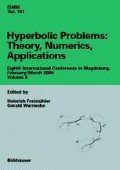Abstract
The problem of spurious solutions due to the violation of Gauss’ law in computational electromagnetics is avoided by solving an equivalent Maxwell system that takes this constraint into account. A second-order accurate finite-volume method is proposed to solve this linear, first-order strictly hyperbolic reformulated system. Numerical examples demonstrate the validity of this approach.
Access this chapter
Tax calculation will be finalised at checkout
Purchases are for personal use only
Preview
Unable to display preview. Download preview PDF.
References
Hockney R.W., and Eastwood J.W. (1981). Computer Simulation using Particles. McGraw-Hill, New-York.
Birdsall C.K., and Langdon A.B. (1985). Plasma Physics via Computer Simulation. McGraw-Hill, New-York.
Boris J.P. (1970). Relativistic Plasma Simulations - Optimization of a Hybrid Code.Proc..4th Conf. on Num. Sim. of Plasmas3–67, NRL Washington, Washington DC.
Assous F., Degond P., Heintze E., Raviart P.-A. and Segr¨¦ J. (1993). On a finite-element method for solving the three-dimensional Maxwell equations.J. Comput. Phys. 109: 222.
Marder B. (1987). A method incorporating Gauss’ law into electromagnetic PIC codes.J. Comput. Phys. 68: 48.
Nielsen D.E., and Drobot A.T. (1990). An analysis of the pseudo-current method.J. Comput. Phys.,89:31–40.
Langdon A.B. (1992). On enforcing Gauss’ law in electromagnetic particle-in-cell codes.Comput. Phys. Commun. 70: 447–450.
Jiang B.N., WuJ.and Povinelli L.A. (1996). The origin of spurious solutions in computational electromagnetics.J. Comput. Phys.,125:104.
Strang G. (1968). On the construction and comparison of difference schemes.SIAM J. Num. Anal. 5: 505.
Munz C.-D., Omnes P. and Schneider R. (2000). A three-dimensional finite-volume solver for the Maxwell equations with divergence cleaning on unstructured meshes.Comput. Phys. Commun. 130: 83–117.
Munz C.-D., Omnes P., Schneider R., Sonnendrücker E. and Voß U. (2000). Divergence correction techniques for Maxwell solvers based on a hyperbolic model.J. Comput. Phys. 161: 484–511.
Munz C.-D., Schneider R., Sonnendrücker E. and Voß U. (1999). Maxwell’s equations when the charge conservation is not satisfied.C. R. Acad. Sci. 328: 431.
van Leer B. (1979). Towards the ultimate conservative difference scheme V. A second order sequel to Godunov’s method.J. Comput. Phys. 32: 101.
Sonar T. (1997). Mehrdimensionale ENO-Verfahren. Teubner, Advances in Numerical Mathematics, Stuttgart.
Friedrich O. (1998). Weighted essentially non-oscillatory schemes for the interpolation of mean values on unstructured grids.J. Comput. Phys. 144: 194.
Munz C.-D. and Schneider R. (2000). An arbitrary high order accurate finite-volume scheme for the Maxwell equations in two dimensions on unstructured meshes. In preparation.
Author information
Authors and Affiliations
Editor information
Editors and Affiliations
Rights and permissions
Copyright information
© 2001 Springer Basel AG
About this paper
Cite this paper
Munz, CD., Omnes, P., Schneider, R. (2001). Enforcing Gauss’ Law in Computational Elec-Tromagnetics Within a Finite-Volume Framework. In: Freistühler, H., Warnecke, G. (eds) Hyperbolic Problems: Theory, Numerics, Applications. ISNM International Series of Numerical Mathematics, vol 141. Birkhäuser, Basel. https://doi.org/10.1007/978-3-0348-8372-6_28
Download citation
DOI: https://doi.org/10.1007/978-3-0348-8372-6_28
Publisher Name: Birkhäuser, Basel
Print ISBN: 978-3-0348-9538-5
Online ISBN: 978-3-0348-8372-6
eBook Packages: Springer Book Archive

